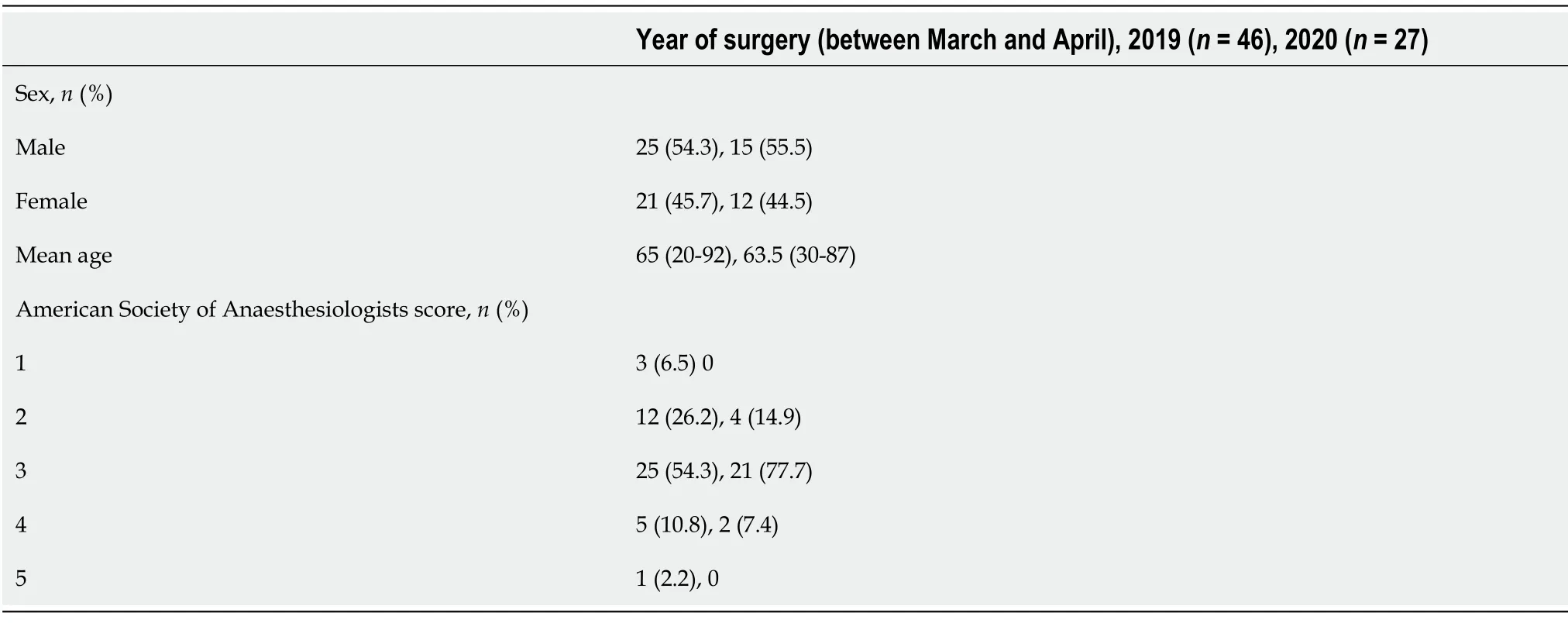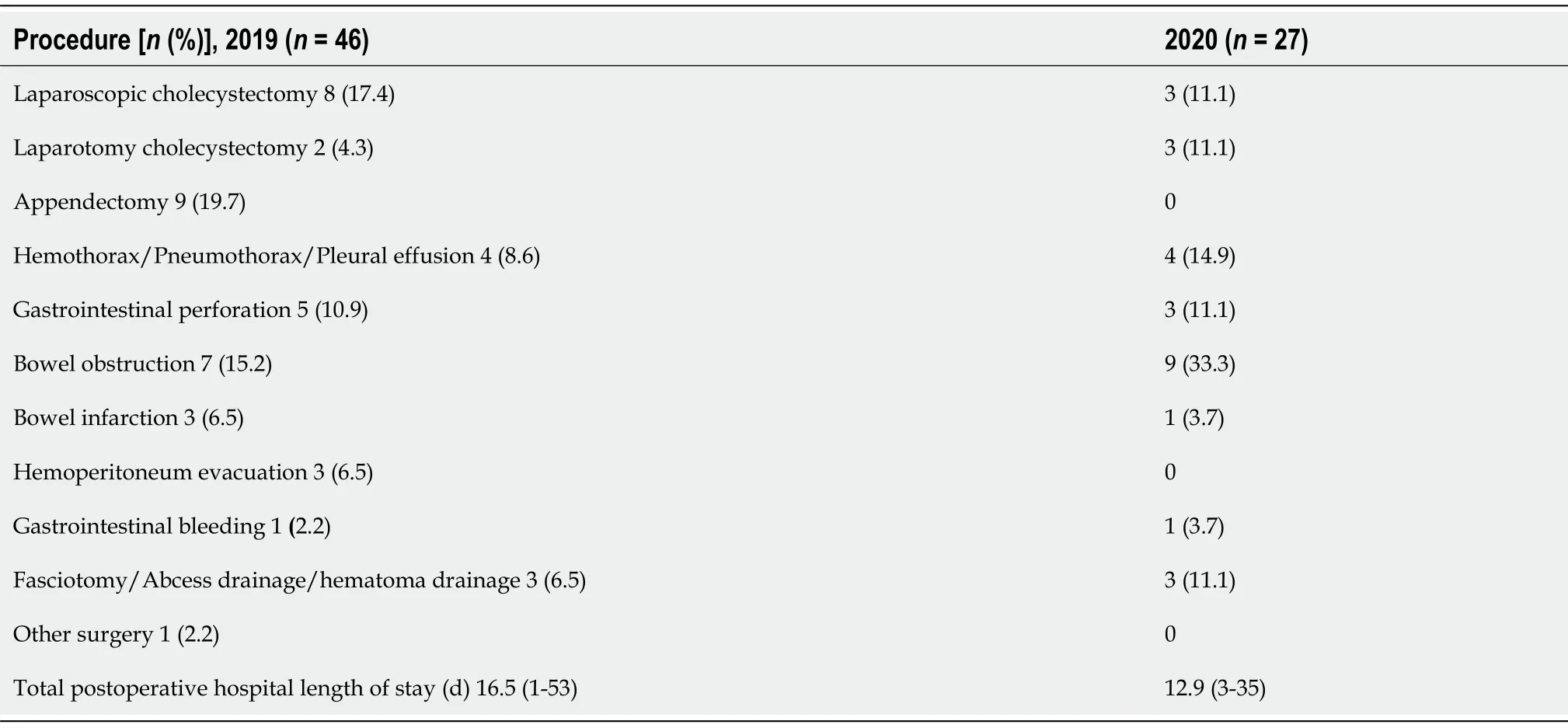Emergency surgery in COVID-19 outbreak:Has anything changed?Single center experience
Francesco D'Urbano,Nicolò Fabbri,Margherita Koleva Radica,Eleonora Rossin,Paolo Carcoforo
Francesco D'Urbano,Margherita Koleva Radica,Eleonora Rossin,Paolo Carcoforo,Department of Morphology,Experimental Medicine and Surgery,Section of General Surgery,University of Ferrara,Ferrara 44100,Italy
Nicolò Fabbri,Unit of General Surgery,Azienda Unità Sanitaria Locale di Ferrara,Ferrara 44100,Italy
Abstract
Key words:COVID-19;Emergency surgery;Outbreak
INTRODUCTION
Since the first outbreak of the new coronavirus disease 19 (COVID-19) in Wuhan,China in December 2019,the virus has spread globally,infecting almost 5 million people to date in more than 180 countries around the world and changing the organization of healthcare.
In the face of a rapidly spreading outbreak in Italy,on March 9,2020,the Italian government ordered a “lock down”,imposing strict restrictions on the movement of the population.Citizens were only allowed to leave home when it was strictly necessary,including for work-related and health-related reasons.In addition,the lock down imposed the temporary closure of all non-essential shops and businesses.
The Italian health care system is faced unprecedented pressure,which threatened to undermine its effectiveness and sustainability.The exponential increase in emergency room visits and inpatient admission volumes in hospitals due to COVID-19 or suspected COVID-19 cases resulted in a major reduction in the surgical case loads comprising emergency or elective cancer cases.
During the lock down,at Sant’Anna University Hospital in Ferrara,Italy,all nonurgent and non-cancerous procedures were canceled so that nurses and anesthesiologists could be reallocated to cope with the COVID-19 emergency.Operating theaters were converted to intensive care unit beds where non-COVID-19patients were relocated,further limiting the ability of the hospital to perform even urgent elective cancer surgeries.
The Department of General Surgery in Ferrara has 46 beds divided among general,thoracic and vascular surgery and an additional 24 beds dedicated to emergency surgery in a separate ward.Normally,daily surgical activity is divided among three operating rooms for elective surgeries and one for emergency surgery.
Within the first weeks of the outbreak,surgical activities were progressively reduced to the point that only one operating room per day was available for elective cancer cases and another operating room for emergency surgery.Moreover,the number of beds used for surgical patients had to be reduced to dedicate beds and personnel to the new COVID-19 wards.The emergency surgery Unit and Uro-Gynecology Unit became COVID-19 wards,and all their beds were merged together in the General Surgery Department,together providing 46 beds between General,Thoracic,Vascular,emergency surgery and Uro-Gynecology.
The aim of the present study was to investigate whether there was a difference in the number of emergency surgeries performed and patient outcomes during the March-April 2020 peak of the COVID-19 emergency compared to the exact same period in 2019.
MATERIALS AND METHODS
This retrospective study was carried out in the General Surgery Department of the Sant’Anna University Hospital in Ferrara,Italy.We examined all the adult patients who underwent emergency surgery from March 9 to April 9,2019 and during the first month of the lock down,from March 9 to April 9,2020.The data collected included the patient’s age,gender,American Society of Anesthesiologists score,type of surgery,postoperative complications and postoperative hospital stay.Postoperative complications were defined as wound infections,pneumonia,bleeding and anastomosis leaks.
During the lock down period,COVID-19 screening with high resolution computerized tomography (HRTC) and nose-pharyngeal swabs was carried out only in the event of clear symptoms or recent contact with a COVID-19 positive patient.All suspected COVID-19 patients were assigned to designated COVID-19 operating areas[1].
Patient data were collected through the following:(1) The SAP (Systeme,Anwendungen,Produkte in der Datenverarbeitung) database of the hospital;(2) The archive of scanned folders to e-care CUP (centro unico di prenotazioni) 2000;and (3)The Ormaweb (Dedalus Spa) operating registry.
Our study was approved by the Clinical Institute Ethics Committee,and the need for informed consent from patients was waived because of the retrospective design of the investigation.
RESULTS
A total of 27 patients underwent emergency surgery at Sant’Anna University Hospital in Ferrara during the first month of lock down,between March 9 and April 9,2020 compared to 46 patients who underwent emergency surgery in the same period in 2019.Hence,there was an overall (41.3) reduction in the number of patients who were hospitalized and underwent emergency surgery during the lock down period.
The mean age was slightly higher in 2019 than it was 2020 (65 yearsvs63.5 years),and both groups had a higher proportion of male patients.The details of the types of surgeries performed for specific diagnoses and the patients’ American Society of Anesthesiologists scores are reported in Tables 1 and 2.
The complication rate during the pandemic increased substantially to 15 out of 27 cases (55.5),compared to 17 out of 46 cases (36.9) recorded in 2019.The mean length of hospitalization in 2019 was 16.5 d,ranging from 1 to 53 d,while in 2020,it was 12.9 d,ranging from 3 to 35 d.The fatality rate after surgery during the pandemic decreased to (11.1) compared to the (19.6) rate recorded in 2019.Table 3 Among the 27 patients who underwent emergency surgery during the pandemic,10 patients were screened for COVID-19 with both thorax HRTC and a nose-pharyngeal swab,and 9 patients were only subject to thorax HRTC.Only 1 patient was found to be positive for SARSCoV-2 and died after surgery (Table 4).

Table 1 Baseline characteristics and perioperative variables of all study population

Table 2 Admission for specific diagnosis and type of surgery in 2019 and 2020

Table 3 Surgical outcomes and vital status for emergency surgery2019 (n = 46),2020 (n = 27)
DISCUSSION
The main finding of the present study was the dramatic reduction in the number of emergency surgeries at our center during the March-April 2020 peak of the COVID-19 emergency in Italy.This finding probably reflects what occurred across Italy during this period.In fact,admissions for surgical emergencies at the emergency room at our hospital were halved during the pandemic compared to the same period in the previous year.The identification of the mechanisms leading to this reduction in admissions for surgical emergencies is beyond the scope of the present work.
Nevertheless,we can assume that multiple factors likely contributed to the phenomenon.First,the fear of contagion at the hospital may have discouraged access to the emergency room,particularly after the media disseminated the news that the virus was easily spread among hospitalized patients and health care workers due to the lack of personal protective equipment.

Table 4 Preoperative investigations and coronavirus diseasepositive patients
A second hypothesis is linked to the fact that the emergency medical system was focused on COVID-19,and most healthcare resources were reallocated to manage the crisis.This focus on the COVID-19 emergency may have led medical staff to defer less urgent cases.In line with this hypothesis is the reduction in hospitalizations for acute appendicitis.Specifically,not a single appendectomy was performed during the pandemic,while nine appendectomies were performed during the analogous period in 2019.In fact,as suggested by Collardet al[2].In their review,management of noncomplicated acute appendicitis in adults should be adapted to each health care facility and its capabilities.In the case of our center,medical treatment with oral antibiotic therapy alone is an option in the case of non-accessibility to the operating room,nonavailability of the necessary OR staff or the fact that all the post-intervention beds are occupied by COVID-19 positive patients,creating an increased risk of infection of the patient who must undergo surgery[2].It should again be pointed out that during the peak of the COVID-19 outbreak,our bed capacity for surgical patients was reduced by over 50.
Finally,we cannot completely exclude the possibility that a true reduction in traumas as a result of the lock down,which imposed restrictions on the movement of the population,may have contributed to the reduction in hemoperitoneum evacuation for abdominal traumas.
Furthermore,the higher complication rate following surgery that was reported during the lock down period may stem from the fact that surgical patients were reaching out to the hospital too late,even though the sample size of the present study was small and can’t be statistically relevant in terms of mortality and complications rate.
A similar reduction in hospitalizations for Acute Myocardial Infarction was also recorded during the March-April 2020 peak of COVID-19 pandemic across Italy[3].
CONCLUSION
There was a significant reduction in emergency surgeries at our center during the March-April 2020 Lock down phase of the COVID-19 pandemic,and it is plausible that an analogous reduction occurred across Italy for the reasons we cited above.It is our hope that the conventional tendency to offer aggressive diagnoses and treatments to too many patients in surgical settings and beyond will be reassessed and reconsidered thanks to the experience acquired during this unprecedented epidemiological crisis.
ARTICLE HIGHLIGHTS
Research background
The current coronavirus disease 19 pandemic is changing the organization of health care and has had a direct impact on the management of surgical patients.
Research motivation
In this article,we highlight how this outbreak could change the flow of surgical patients for many reasons,compared to the same period before pandemic in the main University hospital with an urban population.
电影里面的宫宝森字羽田,正好合了宫宝田的名字,以至于很多人认为宫宝森的形象是以宫宝田为主,但实际上,宫宝森真正称得上宗师的那部分形象,基本上全都来源于李存义,而宫宝田,只是提供了姓名和家庭住址而已。
Research objectives
This study wants to compare 2 different period (from March 9 to April 9 2019 and from March 9 to April 9 2020),searching differences in terms of number and type of interventions in emergency surgery of a main University Hospital in Ferrara,a city in Emilia Romagna region,North of Italy.
Research methods
Data were retrospectively collected using SAP (Systeme,Anwendungen,Produkte in der Datenverarbeitung) database and the Ormaweb (Dedalus Spa) operating registry.
Research results
A total of 27 patients underwent emergency surgery at Sant’Anna University Hospital in Ferrara during the first month of lock down,between March 9 and April 9,2020 compared to 46 patients who underwent emergency surgery in the same period in 2019.The complication rate during the pandemic increased substantially to 15 out of 27 cases (55.5),compared to 17 out of 46 cases (36.9) recorded in 2019.The mean length of hospitalization in 2019 was 16.5 d,ranging from 1 to 53 d,while in 2020,it was 12.9 d,ranging from 3 to 35 d.The fatality rate after surgery during the pandemic decreased to (11.1) compared to the (19.6) rate recorded in 2019.
Research conclusions
There was a significant reduction in emergency surgeries at our center and it is plausible that an analogous reduction will occur in other hospitals.
Research perspectives
It is desirable that the countries affected by the pandemic reorganize their surgical activities and health workers.
 World Journal of Clinical Cases2020年17期
World Journal of Clinical Cases2020年17期
- World Journal of Clinical Cases的其它文章
- Autoimmunity as the comet tail of COVID-19 pandemic
- Gender medicine:Lessons from COVID-19 and other medical conditions for designing health policy
- Complexities of diagnosis and management of COVID-19 in autoimmune diseases:Potential benefits and detriments of immunosuppression
- Incidental anal 18fluorodeoxyglucose uptake:Should we further examine the patient?
- Somatostatin receptor scintigraphy in the follow up of neuroendocrine neoplasms of appendix
- Efficacy of stool multiplex polymerase chain reaction assay in adult patients with acute infectious diarrhea
